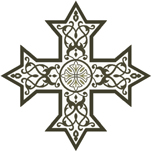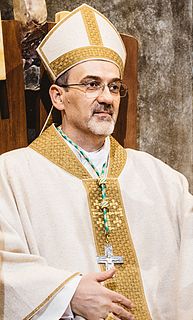 W
WThe Coptic Catholic Patriarchate of Alexandria is the Patriarchal and only Metropolitan see of the head of the Eastern sui iuris Coptic Catholic Church, a particular Church in the Catholic Church in full communion with the Holy See, which follows the Alexandrian Rite in its own Coptic language. He is thus the superior of all Coptic dioceses, mostly in and around Egypt, the word Copt(ic) being a corruption of the Greek word for Egypt(ian).
 W
WThe Greek Orthodox Patriarch of Alexandria has the title Pope and Patriarch of Alexandria and all Africa.
 W
WThe Patriarch of Alexandria is the highest-ranking bishop of Egypt. The Patriarchs trace back their lineage to Mark the Evangelist.
 W
WThe patriarch of Antioch is one of the Eastern Orthodox patriarchs, the leader of the autocephalous Greek Orthodox Church of Antioch. The term "Greek" does not refer to ethnic origin; the majority of these patriarchs were not ethnic Greeks. It refers to the fact that this church follows the Chalcedonian Orthodoxy associated with the (Greek-speaking) Byzantine Empire. Since 518, there have been two Orthodox patriarchs of Antioch: the Chalcedonian ones listed here, and the non-Chalcedonian Syriac Orthodox patriarchs of Antioch.
 W
WThe Patriarch of Antioch was the head of the Church of Antioch. According to tradition, the bishopric of Antioch was established by Saint Peter in the 1st century AD and was later elevated to the status of patriarchate by the First Council of Nicaea in 325. The church first underwent schism after the deposition of Eustathius in 330 over the issue of the Arian controversy and persisted until its resolution in 414.
 W
WThe Melkite Catholic Patriarchate of Antioch is the only actual residential Patriarchate of the Melkite Greek Catholic Church. It was formed in 1724 when a portion of the Orthodox Church of Antioch went into communion with Rome, becoming an Eastern Catholic Church, while the rest of the ancient Patriarchate continues in full communion with the rest of the Eastern Orthodox Church.
 W
WIn 638, the Armenian Apostolic Church began appointing its own bishop in Jerusalem, generally known as the Armenian Patriarch of Jerusalem. The office has continued, with some interruptions, down to this day.
 W
WThe following is a list of patriarchs of All Bulgaria, heads of the Bulgarian Orthodox Church. The Bulgarian Orthodox Church was recognized as an autocephalous archbishopric in 870. In 918 or 919 the Bulgarian monarch Simeon I summoned a church council to raise the Bulgarian Archbishopric to a completely independent patriarchate. With the Byzantine–Bulgarian Treaty of 927, which affirmed the Bulgarian victory over the Byzantine Empire in the War of 913–927, the Ecumenical Patriarch of Constantinople recognized the Bulgarian Patriarchate.
 W
WThis is a list of the Chaldean Catholicoi-Patriarchs of Babylon, the leaders of the Chaldean Catholic Church and one of the Patriarchs of the east of the Catholic Church starting from 1553 following the schism of 1552 which caused a break in the Church of the East, which later led to the founding of the Chaldean Catholic Church.
 W
WThe Patriarch of the Church of the East is the patriarch, or leader and head bishop of the Church of the East. The position dates to the early centuries of Christianity within the Sassanid Empire, and the church has been known by a variety of names, including the Church of the East, Nestorian Church, the Persian Church, the Sassanid Church, or East Syrian. In the 16th and 17th century the Church, by now restricted to its original Assyrian homeland in Upper Mesopotamia, experienced a series of splits, resulting in a series of competing patriarchs and lineages. Today, the three principal churches that emerged from these splits, the Assyrian Church of the East, Ancient Church of the East and the Chaldean Catholic Church, each have their own patriarch, the Patriarch of the Assyrian Church of the East, the Patriarch of the Ancient Church of the East and the Patriarch of Babylon of the Chaldeans, respectively.
 W
WThis is a list of the Patriarchs of Constantinople.
 W
WThe Eritrean Orthodox Tewahedo Church is part of the Oriental Orthodox communion, and it was granted autocephaly by Shenouda III, Pope of the Coptic Orthodox Church of Alexandria, in 1994 — a year after Eritrea gained its independence from Ethiopia. Shenouda III ordained five Eritrean high-ranking clergy as Bishops of the Eritrean Orthodox Tewahedo Church on 19 June 1994 in Saint Mark's Coptic Orthodox Cathedral in Cairo. This would allow the formation of a local Holy Synod for Eritrea. Shenouda III also agreed that a newly elected Patriarch would be able to consecrate on his own new bishops and metropolitans for the Eritrean Church. The Patriarch of Eritrea also carries the title of Abuna in line with the Ethiopian Orthodox Tewahedo Church.
 W
WThis is a list of the abunas of Ethiopia, the spiritual heads of the Ethiopian Orthodox Tewahedo Church. The Abuna is known officially as Patriarch and Catholicos of Ethiopia, Archbishop of Axum and Ichege of the See of Saint Taklehaimanot. Abune Merkorios acceded to this position in May 1988, while Abune Mathias acceded on 28 February 2013. Currently, both men are serving as Co-Patriarchs, following an agreement made on 27 July 2018.
 W
WThis is a list of the Patriarchs of Grado. The patriarchate came into being when the schismatic Patriarch of Aquileia, Paulinus (557–569), moved to Grado in the mid 6th century. But in its reunion with Rome in 606, a rival office was set up in Old-Aquileia. Initially, the patriarchs in Grado claimed the title of Patriarch of Aquileia but in the early 700s it was officially changed to Patriarch of Grado. Old-Aquileia later entered communion with Rome but was able to keep its independence and title from Grado. Throughout their history, the patriarchs of Grado, with the support of Venice, fought military, politically, and ecclesiastically the patriarchs of Aquileia, who were supported by the Lombards, then the Carolingians and the Holy Roman Emperors. The dispute between Grado and Aquileia was partially resolved in 1132 by Pope Innocent II, who restored many of the traditional episcopates to Aquileia, including the Diocese of Istria, while giving to Grado to the Venetian Lagoon, Split, and the Dalmatian islands of Arbe, Veglia and Ossero. Adrian IV placed the archdiocese of Zara under the jurisdiction of the Patriarchate of Grado, making it a true patriarchate with a metropolitan see under it, the only patriarchate of this kind in Western Europe besides Rome. After 1349, the patriarch of Grado and his subordinates were chosen by the venetian Senate, and the names merely sent to Rome for confirmation. In 1451, with the papal bull Regis aeterni, Nicholas V merged the see of Grado with Castello to form the Roman Catholic Archdiocese of Venice. The Patriarch of Venice derived its patriarchal rank from Grado. Throughout its existence, the Patriarchate of Grado was tied to the rising and powerful city of Venice, which was in the ecclesiastical jurisdiction of Grado, rather than to the small city of Grado. The Patriarchs often resided in the church of San Silvestro in Venice where they were officially 'visitors', since canon law did not allow them to reside permanently in territory of another diocese.
 W
WThe Greek Orthodox Patriarch of Jerusalem or Eastern Orthodox Patriarch of Jerusalem, officially Patriarch of Jerusalem, is the head bishop of the Greek Orthodox Patriarchate of Jerusalem, ranking fourth of nine Patriarchs in the Eastern Orthodox Church. Since 2005, the Eastern Orthodox Patriarch of Jerusalem has been Theophilos III. The Patriarch is styled "Patriarch of the Holy City of Jerusalem and all Holy Land, Syria, beyond the Jordan River, Cana of Galilee, and Holy Zion." The Patriarch is the head of the Brotherhood of the Holy Sepulchre, and the religious leader of about 130,000 Eastern Orthodox Christians in the Holy Land, most of them Palestinians.
 W
WThe Latin Patriarchate of Jerusalem is the Catholic episcopal see of Jerusalem, officially seated in the Church of the Holy Sepulchre. It was originally established in 1099, with the Kingdom of Jerusalem encompassing the territories in the Holy Land newly conquered by the First Crusade. From 1374 to 1847 it was a titular see, with the patriarchs of Jerusalem being based at the Basilica di San Lorenzo fuori le Mura in Rome. A resident Latin patriarch was re-established in 1847 by Pius IX.
 W
WThis article lists the metropolitans and patriarchs of Moscow, spiritual heads of the Russian Orthodox Church. Since 1308, there have been 59.
 W
WThe Patriarch of All Romania is the title of the head of the Romanian Orthodox Church. The Patriarch is officially styled as Archbishop of Bucharest, Metropolitan of Muntenia and Dobrogea, Locum tenens of the throne of Caesarea Cappadociae and Patriarch of the Romanian Orthodox Church. Patriarch Daniel acceded to this position on 12 September 2007.
 W
WThis chronological list of popes corresponds to that given in the Annuario Pontificio under the heading "I Sommi Pontefici Romani", excluding those that are explicitly indicated as antipopes. Published every year by the Roman Curia, the Annuario Pontificio no longer identifies popes by regnal number, stating that it is impossible to decide which pope represented the legitimate succession at various times. The 2001 edition of the Annuario Pontificio introduced "almost 200 corrections to its existing biographies of the popes, from St Peter to John Paul II". The corrections concerned dates, especially in the first two centuries, birthplaces and the family name of one pope.
 W
WThis article lists the heads of the Serbian Orthodox Church, since the establishment of the church as an autocephalous archbishopric in 1219 to today's patriarchate. The list includes all the archbishops and patriarchs that led the Serbian Orthodox Church under the Serbian Archbishopric and Serbian Patriarchate of Peć. Today, the church is unified under a patriarch who is officially styled as Archbishop of Peć, Metropolitan of Belgrade and Karlovci, and Serbian Patriarch. Patriarch Porfirije acceded to this position on 19 February 2021.
 W
WThe Syriac Catholic Patriarch of Antioch is the head of the Syriac Catholic Church. According to tradition, the patriarchate of Antioch was established by Saint Peter in the 1st century AD, but split into two separate lines of patriarchs after the deposition of Patriarch Severus of Antioch in 518 over the issue of the Council of Chalcedon of 451. The non-Chalcedonian supporters of Severus went on to form what is now known as the Syriac Orthodox Church, whilst the Chalcedonians developed the church now known as the Greek Orthodox Church of Antioch.
 W
WThe Syriac Orthodox Patriarch of Antioch and All the East is the head of the Syriac Orthodox Church. According to tradition, the patriarchate of Antioch was established by Saint Peter in the 1st century AD, but split into two separate lines of patriarchs after the deposition of Patriarch Severus of Antioch in 518 over the issue of the Council of Chalcedon of 451. The non-Chalcedonian supporters of Severus went on to form what is now known as the Syriac Orthodox Church, whilst the Chalcedonians developed the church now known as the Greek Orthodox Church of Antioch.